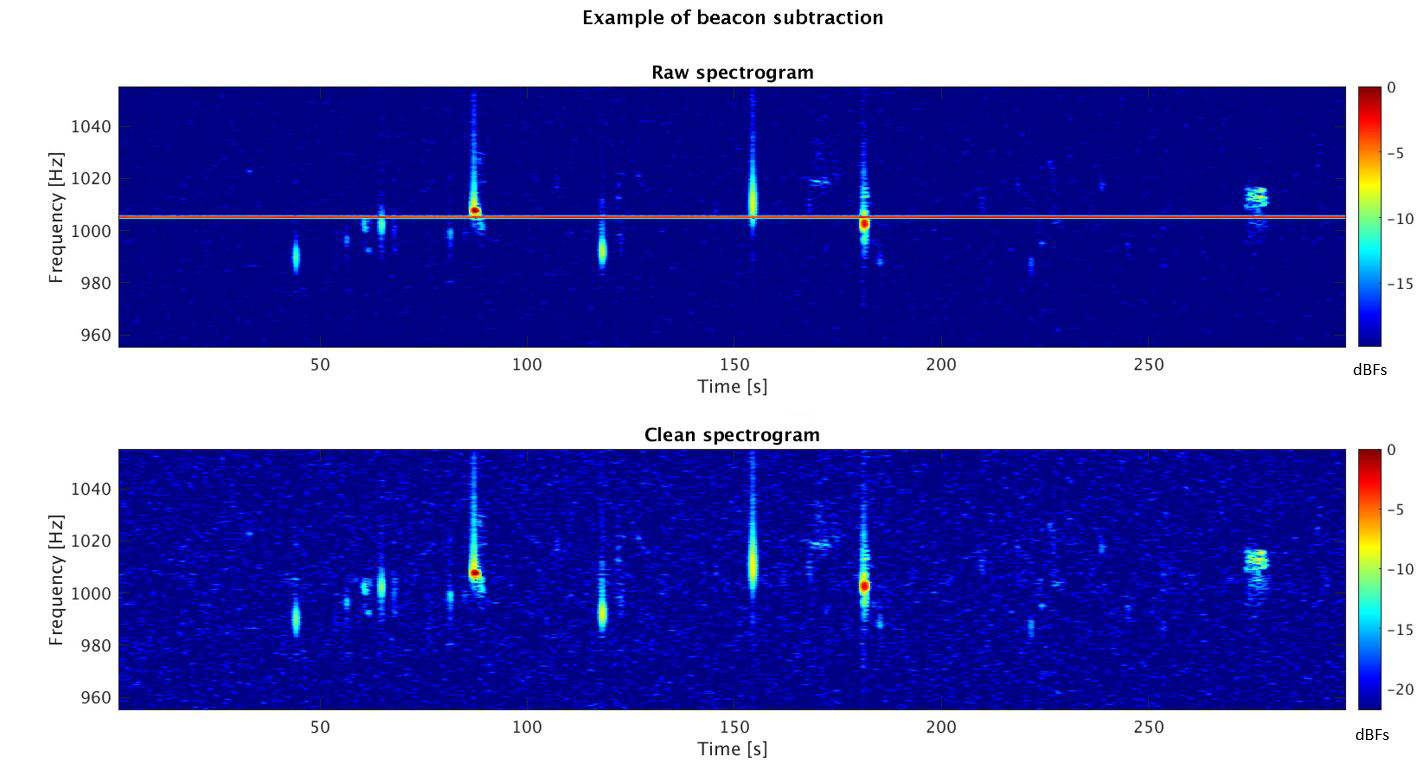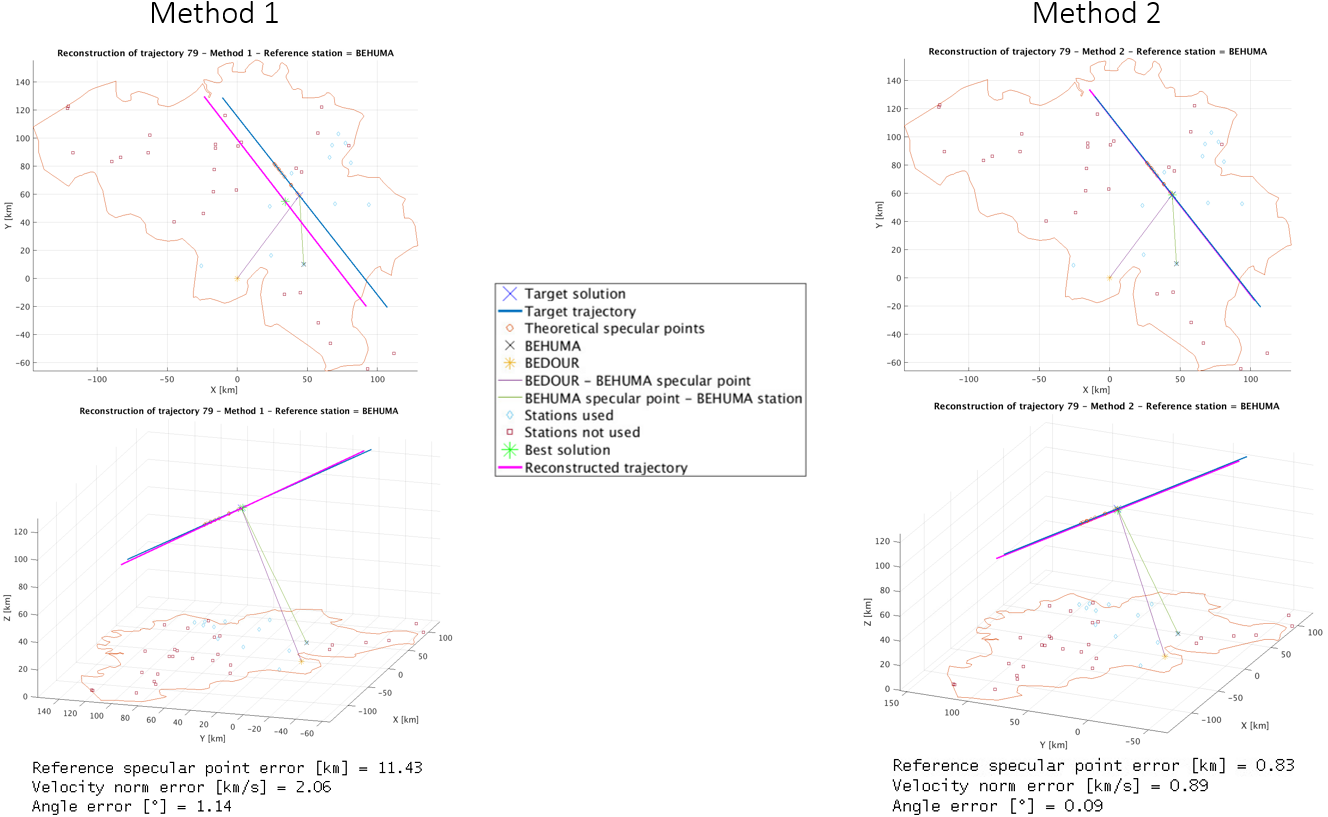Reconstructing meteoroid trajectories using forward scatter radio observations and the interferometer from the BRAMS network
- 1Belgian Institute for Space Aeronomy, Space Physics, Belgium (joachim.balis@aeronomie.be)
- 2STAR Institute, University of Liège, Belgium
When meteoroids hit Earth’s atmosphere molecules, they leave a trail of plasma behind. This region, composed of free electrons and positively charged ions, is capable of reflecting radio signals. The analysis of such signals along the meteoroid path can be used for various scientific purposes: quantification of the electron line density, analysis of the thermosphere properties, characterization of the meteor ablation process, etc. To achieve these objectives, the meteoroid trajectory needs first to be determined.
The reflection on the plasma trails is usually assumed to be specular, which means that the radio wave is reflected only at a given point along the meteoroid trajectory. For forward scatter systems, the position of this specular point depends on the trajectory on the one hand, and on the position of both the emitter and the receiver on the other hand. Using non-collocated receivers, one obtains several specular points along the trajectory. The receivers will thus detect the reflected signal at different time instants on a given trajectory.
In this work, we propose a method that aims at reconstructing meteoroid trajectories using only the time differences of the meteor echoes measured at the receivers of a forward scatter radio system, such as the BRAMS (Belgian RAdio Meteor Stations) network. The latter uses the forward scatter of radio waves on ionized meteor trails to study meteoroids falling in the Earth’s atmosphere. It is made of a dedicated transmitter and 42 receiving stations located in and nearby Belgium. Given that all the BRAMS receivers are synchronized using GPS clocks, we can compute the time differences of the meteor echoes and use them to find the meteoroid trajectory.
Assuming a constant speed motion, the position (three degrees of freedom) and the three velocity components have to be determined. This inverse problem is non-linear and requires the definition of a target objective to minimize. Two different formulations are compared: the first one is based on the minimization of the bistatic range while the second one uses a forward model, which defines the trajectory as being tangential to a family of ellipsoids whose loci are the emitter and each receiver. A Monte-Carlo analysis is performed to highlight the sensitivity of the output trajectory parameters to the input time differences.
The BRAMS network also includes an interferometer in Humain (south of Belgium). Unlike the other receiving stations, it uses 5 antennas in the so-called Jones configuration (Jones et al., 1998; Lamy et al., 2018) and allows to determine the direction of arrival of the meteor echo to within approximately 1°. In that case, the problem becomes much easier to solve because the interferometer gives information about the direction of a reflection point. The benefits brought by such a system regarding the accuracy of the trajectory reconstruction are highlighted.
The post-processing steps allowing to extract meteor echoes from the raw radio signals are described. An approach to properly filter out the direct beacon signal is introduced. Indeed, each receiver detects a more or less strong direct signal coming from the transmitter. This signal does not contain any information about the meteor path since it simply propagates through the atmosphere and is not reflected on the meteor trail. Knowing that the BRAMS transmitter emits a continuous cosine wave, the amplitude, the frequency and the phase are fitted in the frequency domain. The beacon signal is finally reconstructed in the time domain and subtracted. This process in illustrated in the following figure, which shows an example of spectrograms (i.e. time-frequency maps where the power is color-coded) before and after the beacon signal subtraction. The proper removal of the horizontal line at around 1005 Hz (corresponding to the direct signal) is apparent in the bottom spectrogram.

Afterwards, a bandpass filter is necessary to fully exploit the echoes of the detected meteors. Indeed, the raw signal at the time of the meteor echo is noisy and can have interfering signals caused by the reflections on aircrafts. If the latter are at slightly different frequencies than the meteor echo, they produce interference beats. A windowed-sinc filter Blackman filter of high order is therefore used to remove the signal components at frequencies where the meteor echo does not appear. The time corresponding to half-peak power in the rising edge of the echo (which marks the passage of the meteoroid at the specular reflection point) is finally retrieved and the time differences are computed.
To analyze the accuracy of the trajectory reconstructions, data from the optical CAMS-BeNeLux network are used. Promising results showing the reconstructed position, velocity and inclination of several meteoroid trajectories with and without the interferometer are discussed. In the following figure, an example of CAMS trajectory reconstruction obtained with our post-processing is shown. The blue line corresponds to the trajectory determined with the CAMS network, while the purple line is obtained through our analysis of the radio signals obtained at the BRAMS receivers. The reconstructed trajectory using the time differences only (method 1) is shown on the left. The trajectory obtained thanks to the combination of time differences and interferometric data (method 2) is given on the right.

How to cite: Balis, J., Lamy, H., Anciaux, M., and Jehin, E.: Reconstructing meteoroid trajectories using forward scatter radio observations and the interferometer from the BRAMS network, Europlanet Science Congress 2022, Granada, Spain, 18–23 Sep 2022, EPSC2022-227, https://doi.org/10.5194/epsc2022-227, 2022.

